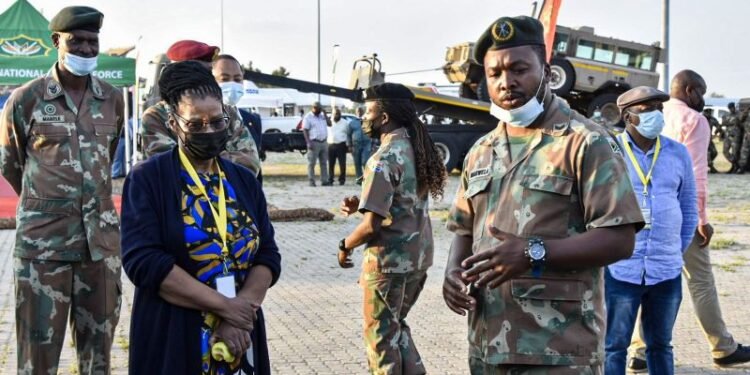
In six months’ time, South Africa should have an indication of what revised levels of “defence ambition” and “defence strategic trajectory” the country’s securocrats have in mind.
While seemingly ambitious – given the timeline as it stands at present – it changes markedly when taking into account the phrases are from the foreword to the 2022/23 Department of Defence (DoD) annual report by Defence and Military Veterans Minister, Thandi Modise. The report covers the 2022/23 financial year ending on 31 March this year.
There is no further ministerial input on this specific in the report, which has yet to find its way onto the DoD website as a public document, although several months ago Modise said in a parliamentary reply that initiatives are underway to realign the DoD under “a revised level of defence ambition”. They include development of a future RSA defence and security policy concept that takes into account the emerging security environment and constraints facing the SANDF as well as development of the Chief of the SANDF’s long-term capability development strategic plan and others.
“Work has continued strongly in these areas, focused on the five military priorities that I outlined in my budget speech,” Modise wrote in her parliamentary reply. They are promoting nation building, safeguarding the nation and building internal stability by strengthening institutions of State and growing the economy; securing regional development by creating conditions conducive to regional security and stability as well as increased investment that drives regional growth and development through consumer economies; enhancing cyber resilience through protection of critical digital infrastructure; and enhancing SANDF hard power capability through a small but core major combat capability relevant and ready to meet future conflict challenges.
“I intend to bring in all stakeholders to participate in work sessions, which will lead to engagements with the two Parliamentary committees in the next four months, where we will discuss the draft defence and national security policy concept as well as the future military capstone concept. I trust this process will lead to a new long-term capability development strategy,” her response ended.
Explaining the rationale behind apparently major changes in the offing, Modise tells those reading the most recent annual report she was “directed” by President Cyril Ramaphosa, Commander-in-Chief of the SA National Defence Force (SANDF), to “evaluate” implementation of the Defence Review 2015. The 2015 document is a successor to the South African Defence Review 2012 produced by Roelf Meyer and his team on instruction from the then holder of the defence and military veterans portfolio, Lindiwe Sisulu.
Modise’s foreword on defence ambition and strategic trajectory continues giving three areas where “work has commenced”.
They are: development of a future South African defence and security policy concept, “cognisant of the emerging security environment and constraints facing the defence function”; developing a future military capstone [one definition is “a crowning achievement”] concept “that will provide the strategising concepts on how to pursue our [South Africa’s] national defence and security policy”; and a long term capability development strategic plan for the SANDF. This, she writes, “will direct the development path of the SANDF for the next 20 years.” General Rudzani Maphwanya, SANDF Chief, “coined this the ‘Journey to Greatness’”.
Work, she informs readers, will begin to “reconfigure, reposition and reorganise the Department [of Defence] to ensure coherent command and control and appropriate governance and accountability”.
A procurement review, consequence management and ensuring that defence assets, named as “movable, tangible” are verified are part of this three-pronged effort. She notes “a considerable amount” of the DoD’s R129 billion assets have been “physically verified” adding “legacy common information and technology systems” are unable to “integrate and blend financial and logistic information”. Also on assets, Modise points a finger at “some unit commanders” who don’t “perform all their resource management command responsibilities.”
Armscor is tasked to “extensively” focus on extending the lifespan of equipment “key in highly probable operations” using “relatively mature commercial technologies in the so-called spin-in approach”.
Modise’s foreword ends sombrely stating “every appreciation process of the DoD points to the inevitable need for more boots on the ground to execute the many tasks given”. On the contrary she puts it that “government directs the downward management of the human resource baseline” making it “our duty to reconcile these mutually exclusive positions”.
“Sustained funding of the DoD remains an unavoidable requirement,” according to her.










